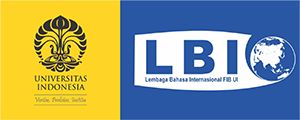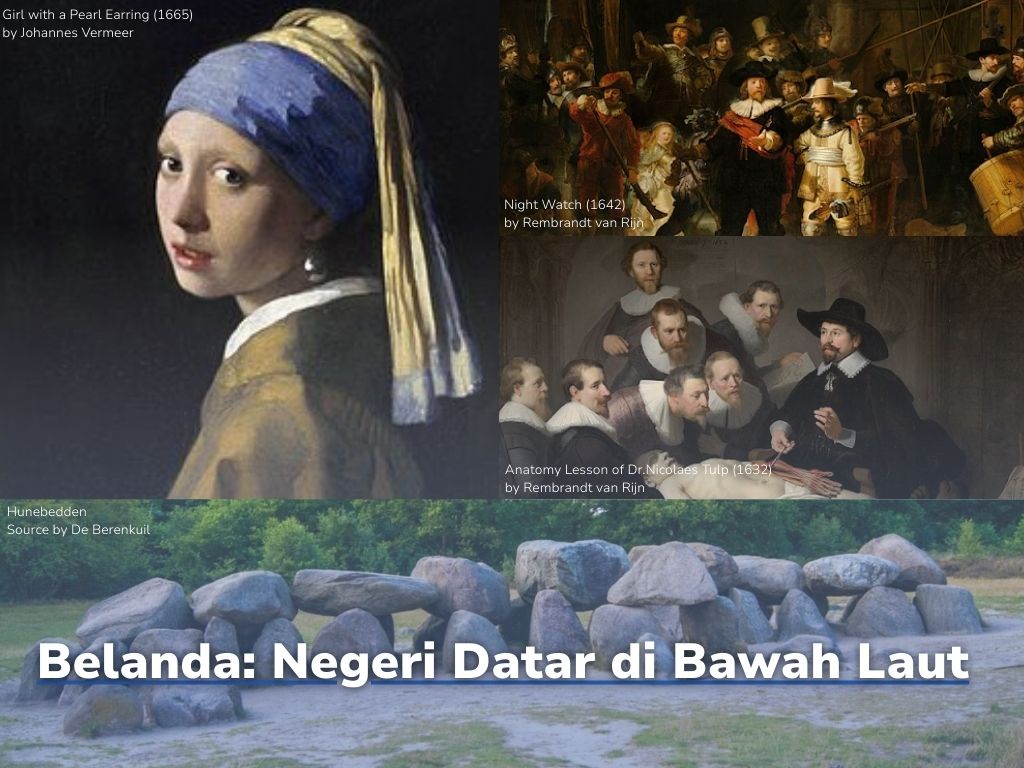Negeri Datar di Bawah Laut
(Artikel ini dibuat oleh Kedutaan Besar Belanda di Indonesia untuk LBI FIB UI)
Lima ribu tahun yang lalu, para raksasa dari masa kuno – dikenal sebagai Huynen – menyeret batu-batu besar dan menumpuknya untuk membentuk Hunebedden: ruang batu yang berfungsi sebagai makam. Setidaknya, begitulah cerita yang berkembang pada masa itu ketika belum ada penjelasan yang masuk akal tentang bagaimana batu seberat 20.000 kg bisa disusun sedemikian rupa. Hunebedden merupakan peninggalan budaya tertua yang dimiliki oleh Belanda (Wayenberg, 2021).
Setelah hampir 5.000 tahun berlalu, Belanda berkembang sebagai tempat yang subur bagi para ilmuwan, seniman, dan masyarakat dari berbagai latar belakang kepercayaan. Kota-kota seperti Amsterdam, Rotterdam, dan Leiden dikenal dengan pola pikir progresif masyarakatnya, yang memberikan ruang bagi para pemikir kreatif untuk mengekspresikan keyakinan mereka. Filsuf besar asal Belanda, Erasmus, menulis buku yang sangat terkenal (atau kontroversial), In Praise of Folly pada tahun 1509, yang secara satir mengkritik berbagai lapisan masyarakat, mulai dari para penjudi miskin hingga gereja yang berkuasa. Kritik tajam Erasmus masih mencerminkan stereotip khas bangsa Belanda yang dikenal tidak segan mengungkapkan pendapat secara jujur dan terbuka.
Sekitar abad ke-17, dunia seni rupa Belanda berkembang pesat dan melahirkan para “Master Belanda”: para pelukis dengan kemampuan luar biasa yang meninggalkan warisan tak ternilai dalam sejarah seni Belanda. Rembrandt van Rijn dan Johannes Vermeer adalah dua seniman paling ternama dari periode ini. Setiap tahun, jutaan orang dari seluruh dunia mengunjungi museum-museum di Belanda untuk melihat langsung karya-karya mereka. Cakupan karya Rembrandt sangat luas, mulai dari lanskap, potret, hingga tema-tema keagamaan; ia merevolusi setiap medium yang ia gunakan, mulai dari lukisan minyak, etsa, hingga sketsa. Pandangannya menangkap berbagai aspek kehidupan, dari singa yang sedang tidur hingga bayi yang sedang marah. Sementara itu, karya Vermeer yang terkenal dengan ‘tatapan tidak langsung’ dan ‘punggung yang membelakangi’ selalu diliputi dengan gaya pencahayaan khas yang memberi kesan sinematik dan hampir transendental (Graf, 2024).
Sekitar seratus tahun yang lalu, bangsa Belanda mulai merasa membutuhkan lebih banyak ruang. Oleh karena itu, mereka menutup laut dengan tanggul raksasa dan menimbun tanah untuk menciptakan danau buatan yang baru. Lahirlah Flevoland, sebuah provinsi yang terbentuk berkat pengalaman berabad-abad dalam menaklukkan Laut Utara. Flevoland diresmikan pada tahun 1986, ketika banyak penduduk kota-kota padat di Belanda mencari ruang tinggal yang lebih luas. Provinsi ini dilindungi oleh tanggul sepanjang puluhan kilometer dan, seperti banyak wilayah lain di Belanda yang dekat dengan laut, Flevoland terletak beberapa meter di bawah permukaan laut (Holland, 2023). Keahlian ini juga diterapkan di berbagai belahan dunia. Van Oord, perusahaan pengerukan dan teknik sipil asal Belanda, juga menjadi kontraktor utama dalam pembangunan Palm Jumeirah, pulau buatan terbesar di dunia.
Secara strategis terletak di Eropa Barat, Belanda sering disebut sebagai “Gerbang Menuju Eropa.” Pelabuhan Rotterdam, yang merupakan pelabuhan terbesar di Eropa, menangani 469 juta ton barang pada tahun 2018, termasuk kontainer, kargo kering dan cair, gas, dan bahan kimia. Tak jauh dari sana, terdapat Bandara Schiphol, salah satu bandara tersibuk di dunia yang melayani lebih dari 300 tujuan penerbangan (Port of Rotterdam Authority, 2019).
Meski Belanda hanyalah satu titik kecil di peta dunia, pengaruhnya dalam bidang teknologi global jauh melampaui ukurannya. Ilmuwan dan insinyur Belanda telah membuat kontribusi revolusioner, termasuk penemuan Wi-Fi oleh seorang peneliti Belanda dan teknologi semikonduktor dari ASML yang menjadi penggerak utama chip dalam hampir semua perangkat elektronik modern. Kesuksesan ini didukung oleh penekanan kuat pada bidang pendidikan dan riset. Belanda adalah rumah bagi beberapa universitas terbaik di dunia, seperti Universitas Teknologi Delft, Universitas Amsterdam, dan Universitas Wageningen. Institusi-institusi ini menarik mahasiswa dari seluruh dunia, menciptakan ekosistem akademik yang beragam dan inovatif. Sistem pendidikan di Belanda sangat berfokus pada pemikiran kritis, kreativitas, dan keterampilan praktis—kualitas-kualitas yang membuat para lulusannya sangat kompetitif di pasar kerja global (Invest in Holland, 2022).
Tentu saja, Belanda tetap merayakan pasar kejunya yang terkenal, ladang tulipnya yang memesona, dan perayaan Hari Raja yang meriah. Setiap tahun, jalan-jalan dipenuhi warna oranye untuk merayakan Hari Raja; para pengunjung berbondong-bondong menyaksikan pasar keju tradisional dan menikmati keindahan ladang tulip yang bermekaran seperti dalam foto yang ditampilkan di atas. Namun, Belanda menawarkan jauh lebih banyak daripada apa yang tampak di permukaan. Bagi generasi muda yang menatap masa depan, Belanda memberikan contoh inspiratif tentang bagaimana sebuah bangsa dapat menghormati sejarahnya sekaligus membangun masa depan. Belanda bukan sekadar Negeri Datar di Bawah Permukaan Laut, melainkan bukti bahwa ukuran sebuah negara tidak menentukan seberapa besar pengaruhnya terhadap dunia.
___________________________________________________________________________________________________________________
About the Flat Country Under the Sea
(This article is made by The Embassy of the Netherlands to Indonesia for LBI FIB UI.)
Five thousand years ago, the giants of ancient times – known as the Huynen – hauled massive stones and stacked them to create the ‘Hunebedden’: stone chambers that served as graves. At least, that’s how the story went back in the day when there was no plausible explanation for the way in which the 20,000 kg stones were stacked. The Hunebedden are the oldest pieces of heritage that we have in The Netherlands (Wayenberg, 2021).
Fast forward to almost 5000 years later and the Netherlands is thriving as a haven for scientists, artists and people from all different religious backgrounds. Cities like Amsterdam, Rotterdam and Leiden were known for their progressive mindset and allowing creative minds to express their beliefs. The great Dutch philosopher, Erasmus, wrote in 1509 the (in)famous book “In Praise of Folly”, in which he ridicules every part of society, from the poor gamblers all the way up to the powerful church. Erasmus’ satirical criticism still fits into the stereotypical view of the Dutch never shying away from directly giving their honest opinion.
In and around the 17th century the artistic field was thriving and the “Dutch Masters” emerged: painters whose unparalleled mastery forms an invaluable legacy to Dutch history.
Rembrandt van Rijn and Johannes Vermeer are two of the most renowned artists from this period. Every year, millions of people from around the world visit the Dutch museums where their masterpieces are displayed. Rembrandt van Rijn’s scope was broad, ranging from landscapes to portraits to Biblical subjects; he revolutionized every medium he worked with, from oil paintings to etchings and sketches. His vision included every aspect of life, from a sleeping lion to an angry baby. Vermeer's masterpiece with the indirect glance and the turned back paintings always drenched in that fuzzy, filmic Vermeer gloss, which appears to elevate them to a higher plane on a daily basis (Graf, 2024).
About a hundred years ago, they decided that they needed more space. That’s why the Dutch closed off the sea with a huge dike and dumped a whole bunch of soil in our new lake. Welcome to Flevoland, a province that only exists because of their centuries long experience fighting off the North Sea. Flevoland was established in 1986, when many people from the densely populated cities longed for more living space. Flevoland is protected by many kilometers of dikes. Just like other parts in the Netherlands situated near the sea, Flevoland lies multiple meters below sea level (Holland, 2023). Their competence also shows in other parts of the world. Van Oord, a Dutch dredging and civil engineering business, was the major contractor for the Palm Jumeirah, a big artificial island.
Situated strategically in Western Europe, you might have heard the Netherlands being referred to as the 'Gateway to Europe.' The Port of Rotterdam, which is the biggest in Europe, handled 469 million tons of goods in 2018, including containers, dry and liquid bulks, specialty items, gas and chemicals. Schiphol Airport is not far from this port, and is one of the world's busiest aviation hubs, having over 300 destinations (Port of Rotterdam Authority, 2019).
Even though the Netherlands is merely a tiny speck on this earth, its impact on global technology is more impressive than its size. Dutch scientists and engineers have made revolutionary contributions, including the invention of Wi-Fi by a Dutch researcher, and ASML’s semiconductor technology, which powers the chips in almost every modern electronic device you can imagine. A big part of this success comes from the strong emphasis on education and research; the Netherlands is home to some of the world's top universities. This includes Delft University of Technology, the University of Amsterdam, and Wageningen University. These institutions attract students from across the world, which then also promotes a diverse and innovative academic domain. The Dutch education system is a big defender when it comes to critical thinking, creativity, and practical skills, which in terms make graduates highly competitive in the global job market (Invest in Holland, 2022).
Sure, the Netherlands still celebrates its famous cheese markets, tulip fields, and King’s Day festivities. Every year, the streets are coloured orange to celebrate King’s Day, visitors flock to the historic cheese markets and tulip fields bloom in vibrant colors as depicted in the photo beside. But the Netherlands has much more to offer than what you may see on the surface. For young people looking to the future, the Netherlands offers an inspiring example of how a nation can honor its past while shaping tomorrow. In the end, the Netherlands is much more than just a flat country below sea level. It is proof that the size of a country has nothing to do with influence.
_______________________________________________
Bibliography
Graf, S. (2024, May 3). 7 Famous Dutch artists who achieved greatness. TheCollector. https://www.thecollector.com/famous-dutch-artists/
Holland, T. T. (2023, October 25). The Dutch made province, Flevoland. https://www.linkedin.com/pulse/dutch-made-province-flevoland-traveltradeholland-8kqte#:~:text=Unlike%20the%20other%20islands%20around,artificial%20island%20in%20the%20world
Port of Rotterdam Authority. (2019). Port of Rotterdam Annual Report. In Port of Rotterdam. Safety4sea. https://www.google.com/url?sa=t&rct=j&q=&esrc=s&source=web&cd=&ved=2ahUKEwisk_GHgb6MAxXsmK8BHX-DEwEQFnoECBYQAw&url=https%3A%2F%2Fsafety4sea.com%2Fwp-content%2Fuploads%2F2019%2F03%2FPort-of-Rotterdam-2018-Annual-Report-2019_03.pdf&usg=AOvVaw3O8XFqdrbPy7AshK6qlpnK&opi=89978449
Invest in Holland. (2022, October 26). NFIA. https://investinholland.com/why-invest/talent/education/
Wayenberg, S. (2021, January 25). Wat zijn hunebedden? NPO Kennis. https://npokennis.nl/longread/7576/wat-zijn-hunebedden
Authors:
-
Hereby, a swift message from myself, Sharon Hoornveld. I grew up in the North of the Netherlands, Friesland, the one and only place in the Netherlands where we have our own language besides Dutch. When I’m not busy stuffing my face with cheese and stroopwafels (just kidding), I like to practise muay thai kickboxing and going to the gym. At the moment, I am an intern at the Culture & Communication department at the Dutch embassy in Jakarta, where I have 6 months to create my graduation thesis for my study, European Studies and my client, the cultural centre of the Dutch embassy in Jakarta, called Erasmus Huis.
-
My name is Kylian Koopmans, born in Amsterdam and raised in the tulip fields! My favourite free time activities are playing drums, training karate and watching sports or movies. For the past three years I have been studying European History at the University of Amsterdam. Currently I am an intern at the Dutch Embassy in Jakarta, where it is my task to create a strategy for sports diplomacy for them to use in the future.

